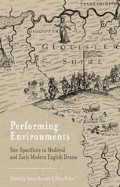Abstract
In Act 3 scene 6 of Cymbeline, Innogen, the play’s heroine, searches for the Welsh port town of Milford Haven, where she plans to reunite with her banished husband, Posthumus. ‘Milford’, she apostrophizes, ‘[w]hen from the mountain-top Pisanio showed thee, / Thou wast in a ken [sight].’2 In her frustration that she still has not found the port, despite having seen it from elevated ground, she laments that ‘[f]oundations fly the wretched’.3 In this moment, Shakespeare registers the difference that contemporary cultural geographers identify between ‘landscape’ and ‘place’. As Innogen discovers, her stance from a distance enabled her to see the port clearly; yet, that same distance means that she has not yet found or inhabited her destination. The very idea of ‘foundation’ is put into question in the ongoing challenge posed by the need to move towards a destination in order to find it. Innogen also reveals that seeing a landscape from a fixed position is different from living in, and moving to and through, places.
I would like to thank Susan Bennett and Mary Polito for their extensive and tireless support in the writing of this chapter.
Access this chapter
Tax calculation will be finalised at checkout
Purchases are for personal use only
Preview
Unable to display preview. Download preview PDF.
Notes
‘Ken’ means ‘sight’ here. William Shakespeare, Cymbeline, The New Cambridge Shakespeare, ed. Martin Butler (Cambridge: Cambridge University Press, 2005) 3.6.4–6. All subsequent references to the play will be from this edition.
Tim Cresswell, Place: A Short Introduction (Malden, MA: Blackwell, 2004) 10.
Garrett A. Sullivan, The Drama of Landscape: Land, Property, and Social Relations on the Early Modern Stage (Stanford, CA: Stanford University Press, 1998) 17.
Ros King writes that a dating period of 1606 to 1611 has been made according to stylistic elements. Simon Forman described seeing Cymbeline in his diary in the months leading up to his death in September of 1611, which thus must be the latest possible date for the staging of the play. See Ros King, Cymbeline: Constructions of Britain (Aldershot: Ashgate, 2005) 37.
W. J. T. Mitchell, Landscape and Power (Chicago, IL: University of Chicago Press, 2002) 17.
Willy Maley, Nation, State, and Empire in English Renaissance Literature: Shakespeare to Milton (Basingstoke: Palgrave Macmillan, 2003) 39.
Leah Marcus, Puzzling Shakespeare: Local Reading and its Discontents (Berkeley, CA: University of California Press, 1990) 116.
Janet Adelman, ‘Shakespeare’s Romulus and Remus: Who Does the Wolf Love?’, in Maria Del Sapio Garbero (ed.), Identity, Otherness and Empire in Shakespeare’s Rome (Farnham: Ashgate, 2009) 32.
Charles Cornwallis, The Life and Death of our Late most Incomparable and Heroique Prince, Henry Prince of Wales (London: John Dawson, 1641), Early English Books Online, 20 (accessed 23 March 2013).
John Peacock, The Stage Designs of Inigo Jones: The European Context (Cambridge: Cambridge University Press, 1995) 3.
Anthony Munday, Londons Loue, to the Royal Prince Henrie, meeting him on the Riuer of Thames, at his returne from Richmonde, with a worthie fleete of her cit- tizens, on Thursday the last of May, 1610. With a breife reporte of the water fight, and fireworkes (London: Edward Allde, 1610), Early English Books Online, C3r (27 March 2013).
Anne Daye, ‘“The power of his commanding trident”: Tethys Festival as Royal Policy’, Historical Dance 4.2 (2012): 19–28 (21).
John Speed’s description of Milford Haven is both place and symbolic landscape. Speed describes the port as ‘an Hauen of such capacitie, that sixteene Creekes, fiue Bayes, and thirteen Roades, knowne all by seuerall names, are therein contained, where Henry of Richmond, of most happy memorie, arri- ued with signall hopes of Englands freedome from vnder the gouernment of an vsurping Tyrant’. See John Speed, The Theatre of the Empire of Great Britaine (London, 1612), Early English Books Online, Cc1r (23 March 2013).
Giovanni Paolo Lomazzo, A tracte containing the artes of curious painting, caru- inge & building, written first in Italian by Io: Paul Lomatius painter of Milan and Englished by R.H student in physik (Oxford: Joseph Barnes, 1598), Early English Books Online, 180 (23 March 2013).
Lisa Hopkins, Shakespeare on the Edge: Border-Crossing in the Tragedies and the Henriad (Aldershot: Ashgate, 2005) 5.
William Shakespeare, Antony and Cleopatra, ed. John Wilders, Arden Shakespeare, 3rd series (London: Routledge 199S) 2.2.210–11.
Copyright information
© 2014 Amy Scott
About this chapter
Cite this chapter
Scott, A. (2014). Cymbeline and the Politics/Poetics of Mobility. In: Performing Environments. Palgrave Macmillan, London. https://doi.org/10.1057/9781137320179_12
Download citation
DOI: https://doi.org/10.1057/9781137320179_12
Publisher Name: Palgrave Macmillan, London
Print ISBN: 978-1-349-45765-6
Online ISBN: 978-1-137-32017-9
eBook Packages: Palgrave Theatre & Performance CollectionLiterature, Cultural and Media Studies (R0)

